1913 Armory Show
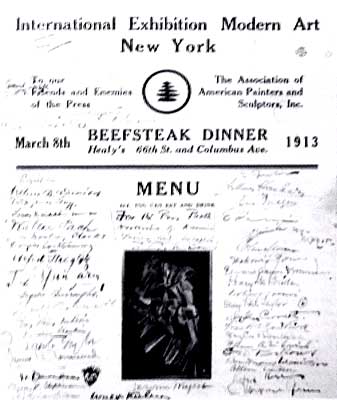
Armory Show was the first "Media event" - as an art exhibition - basically visited by an enormous amount of visitors = 200,000 altogether (NYC 75,000 people / Chicago 100,000 and Boston 25,000).Organised by John Quinn a lawyer, young collector and patron of arts and Arthur B. Davis, in those days one of the most important painters in the USA and the president of the show. Davis saw the catalogue of the Sonderbundausstellung 1912 in Cologne. Quinn took a ship and he arrived in Cologne the last day of the exhibition when the show was already being taken down - he met many people involved in the show. He asked Davis to come to Europe and in Paris they began co-operating with French artists. After they returned to the States, they told the press that they would be showing an extensive collection of "radical" European art. The Armory Show included 500 European and about 1000 American artworks.What's so special about this show:- it was basically done by "amateurs",- all the work was done by artists who came together under the name "The Association of American Painters and Sculptors",- the site, a military depot, and the spectacular exhibition design,- the media's discussion of the works.
1913 "Der erste Deutsch Herbstsalon"
(The First German Autumn Salon)
Organised by the artist gathered around Der Sturm.It was an overview of the new art movement of all countries (to be more exact, of the countries of the western art world) Der Sturm, edited by Herwad Walden, was a journal, a publishing house, a gallery, a school and a theatre - a very early example of an interdisciplinary approach.Walden was a composer as well a writer. Because of his extraordinary energy, he became the focus of Expressionism and a catalyst of Modernism. He wanted the Herbstsalon to be the first of 100 Sturm exhibitions.Der blaue Reiter met with Der Sturm.Walden introduced the Futurists to Germany and was the first to bring James Ensor (Belgium) to Germany, showing his work in his gallery.Important:- The energy of one person.- Information in those days was related to the activities, information and travels of just a few people - these events (as well as Sonderbund and the Armory) changed the arts.
Herbstsalon showed 366 paintings and sculptures by 85 artists from all over Europe, as well as from Russia, India, China, Japan and the USA - this was quite an event to be organised by a single person based on his own private structure.But business as usual was already the case: nobody showing at Herbstsalon was allowed to show with Paul Cassirer (another famous art dealer). At the exhibition all art was for sale; the commission was 15-20% (a common percentage in those days and still common in Kunstverein).The critic Karl Scheffler wrote: "The organiser has caused great damage to 'new art' with an non-reflectively organised exhibition' - the role of Walden as a critic described in a flyer.
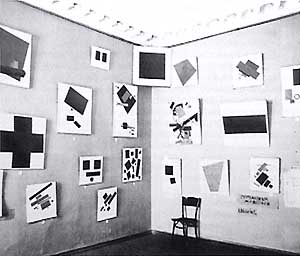
The Last Futurist Exhibition, Petrograd
The show should have been called 0-10, but a printing mistake made it read: 0,10.It was financed by the artist Puni and his wife Buguslavskaja.At this exhibition, Malevich publicly presented for the first time his legendary Black square on white ground. He placed the painting in a similar position as Russian Icons were usually displayed.This exhibition also reflects the conflict between two strong figures, Malevich and Tatlin. This conflict proved to be a powerful drive, while the arenas of the battles were the exhibitions.At 0,10 Malevich and his group introduced the Suprematism for the first time - a higher form of realism and the black square as the highest of them, or supreme.Under the title "suprematist" painting, he showed for the first time works, where 36 objects were replaced by squares, lines and circles.The paintings have caused trouble until today. The black circle was the Zero hour of art.Diaghilev, who saw himself as the father of the new movements in Russia, thought this painting endangered the future - his and that of his shows, which would mean the end of artistic intervention and complete boredom. Tatlin only wanted to show his work if he and Malevich had separate rooms. They had been fighting over which one of them was the leader of the new movement. Tatlin did not want to show his work with those of an "amateur" as he regarded Malevich.For this reason, Tatlin called his section of the show the Exhibition of Professional Painters.In return, Malevich published his own manifesto entitled From Cubism to Suprematism.
First International Dada-Fair, Berlin 1920
fighting for anti-art-
Dada as a name was coined together in 1917 (Zürich) by the artist Richard Huelsenbeck. He was surrounded by the group of artists such as Hausmann, Baader, Grosz and others.According to these artists, critics were full of brutality (it was in the middle of WW I.). They detested the connection between art and military thinking and the hidden chauvinism of thinkers such as Fichte, Hegel and others.
The Dada-Fair,
Berlin, was the last public manifesto.Partly financed by a ceramics dealer
with 3.000 FF and exhibition area, the Dada Fair took place from June
to August. Organizers: Marshal George Grosz, Dadasoph Raoul Hausmann and
Monteurdad John Heartfield.
Public reaction was meagre.
174 dadaist products (they refused to call them art works) by 27 contributors,
at least one of whom was fictitious were displayed. The catalogue was
designed as a newspaper and had 4 pages. It contained Hausmann's extremely
negative critique of the show.The puppet with the pig faced head caused
a trial (because it alluded to the army). It's title was Preussischer
Erzengel.
El Lissitzky: Room of the Abstracts, Hannover 1927/28
This was
not exactly an exhibition, but an exhibition-architecture which replaced
the canvas as the "the base" for artworks of the previous era.
A wall can be moved. A mirror reflects and enlarges a view.
Again, like Dada etc., it was addressed against the bourgeois attitude
towards art. In this room, he introduced fixed materialised Stone sculptures
with the intention to proclaim himself the "son of the October revolution".
He was painting Proun as he called them - a project to find new forms
in art.
Lissitzky's paintings are like building elements used in a three dimensional
space, but through their non fixed and moving structure, he wanted to
reach the 4th dimension.
After Einstein's Theory of Relativity.El Lissitzky was possessed by the
idea of participating in scientific research with artistic methods.
First conceived for Dresden (1926), where the show was seen by the Director
of the Hannover Provincial Museum, Alexander Dorner, who must have been
impressed with it. Thus, he commissioned Lissitzky to create a room for
his museum. Dorner, like Lissitzky, was sure that art had a task to fulfil
in the society. Dorner called art not the product of a single artist but
an expression of the constitution of the contemporary society. This belief
was quite early! And, unfortunately, it is missing in many of today's
museums. He believed in the fourth dimension as well and he and Lissitzky
wanted to make it visible.
Merzbau by artist Kurt Schwitters, Hannover, 1919-1937
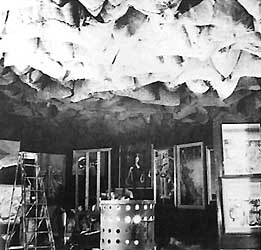
Exposition International du Surréalisme, Paris 1938
In Germany,
the destruction of artistic communities by the National Socialists was
already in full swing.
Place: Galerie de Georges Wildenstein, 140 Rue de Faubourg, Saint Honoré,
Paris
8-page catalogue: organisers were André Breton, Paul Eluard; Intendant
Duchamp; technical assistance by Salvador Dali and Max Ernst; Man Ray
was responsible for lighting, Wolfing Paaten was responsible for water
and plants. Again, the interesting aspect of this was that the show had
been organised by artists themselves and that participating artists made
the arrangements as in a theatre in order to put the show "on stage".
But, again as with a lot of the previous shows, it took place in a period
when the group seemed to be disintegrating and falling apart. Although
attempts at reconciliation were made, the conflict deepened during the
project.
Eluard was put down by Bréton because of his doctrinaire communist attitudes
and Ernst could no longer support or go along with Dali's pro-fascist
attitudes.
Again, exhibition architecture was an incredibly important aspect of the
show.
Duchamp placed 1,200 coal sacks on the ceiling. The show was divided into
three sections: the Foyer with Taxi pluvieux by Dali and two main
parts (Des plus belles rues de Paris with a department store decorated
with androgynous mannequins); the main space, which had been decorated
by Duchamp and equipped with lighting by Man Ray, resembled a Venetian
cave with 1,200 coal sacks hanging from the ceiling and a pond with "sea
roses" and a kind of a fireplace on the ground, around which the
surrealists met in winter as if in a café and "found big heads as
the sign of Love". Behind a screen, coffee was toasted, while from
a loudspeaker, the footsteps of the German army and the ramblings and
screams of crazy people blasted.
After Lissiztky and Merzbau, this represented a complete "interior
scenario" for an exhibition. It was against the white cube.
Peggy Guggenheim: Art of This Century, 1942-1947
68 artists with 171 works for the opening show
"This was a museum and gallery in one."
Exhibition architecture by Frederick Kiessler.
Room of the "abstracts".
Room of the surrealists.
Rooms for changing exhibitions.
Guggenheim worked with a good list of consultants. The entrance fee of $1 U.S., was dedicated to the benefit of The American Red Cross. 10 exhibitions a year, opening hours: Saturday 10-6, Tuesdays until 10 p.m.
Documenta 1, Kassel 1955
founded by Arnold Bode
- staircase: of raw bricks and plastic curtains
first artistic director: Werner Hoffman
The show was put together by a team of art historians and museum people.
This Is Tomorrow, London, Whitechapel Gallery, 1956
Independent Group
1953, a parallel to "Life and Art"
Once again organised by a group of artists who established an independent group which had been formed in 1952 by artists and people working at the ICA in London. Among others: Hamilton, Paolozzi, Passmore, Alison and Peter Smithson. They continued to rethink the function of the exhibition. They held open meetings with artists, including those who did not belong to the group. They decided to create a new kind of an exhibition.
"Everybody invited everybody whom they thought was any good whether architects or artists, they would just talk, come along and talk about it," Theo Crosby remembers. Crosby took over the planning and organisation of the project: "Everybody was allocated a job."
By 1955, 12 teams had been established, shaped or had come out of the meetings and 7 months later they introduced their proposals. As there was hardly any money, considerable improvements were necessary.
The goal was that the artist was to leave his or her specialisation and had to consider science, learn from architecture, etc. The group was interested in an interdisciplinary form of co-operation.
Again the exhibition architecture was a central element of the exhibition. Each group built their own pieces of architecture.
Yves Klein: Le Vide, Galerie Iris Clert; 1958
It is important because it took place in a gallery. The goal was to sell the emptiness.He wanted to show the "immaterial". Again, the whole gallery became the art work, because it framed the "immaterial". A kind of spiritual architecture. Each detail was planned: air as the vehicle of energy through space. This was the beginning of his Poesie de l'espace period, as Gaston Bachelard had called it.
The gallery covered the surface area of only 20 square meters. Yves Klein painted the windows blue and two soldiers stood to the left and right of the entrance throughout the opening. Blue drinks were served. He wanted to illuminate the obelisk at Place de la Concorde with blue light with the permission of the Prefecture.
3,000 people showed up for this vernissage. The space showed the immaterial and outside, the street was crowded with people.
Claes Oldenburg: The Store; 107 East 2nd. Street, N.Y.C., 1961
In fear of turning "bourgeois", Oldenburg tried to leave the art context.
Dubuffet said: "To reinvent artistic life is to link art again to the language of the street."
The artists lived downtown in the slums of the cheap apartments of the Lower East Side, where soon alternative artist spaces opened. Events began to take place. The "beatnik" writers joined the community of the artists and vice versa.
Claes Oldenburg, a Swede, entered this particular scene in 1956. (Rauschenberg had already shown The bed, which consisted of a real slept-in dirty bed.)
He thought a lot about how to replace the museum. With others (Rauschenberg), he came up with the solution that the object itself has to carry all meanings.
He made an inventory of the objects that could be bought directly in the store. The store had regular opening hours like other stores in the neighbourhood.
Critical reflection on the US consumer society as well as the consumerism of the art world.
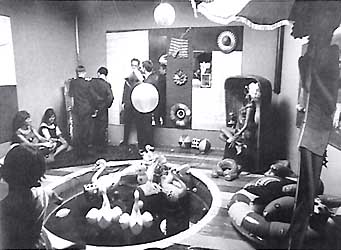
Dylaby - a dynamic labyrinth, Stedelijk museum, 1962
Six artists created an environment directly in the exhibition space of the museum. Most of the material was from marchés aux puces, from second hand stores or it was simply found in the street. When the exhibition closed, most of it landed in the garbage dump. For a museum, Dylaby was, in those days, an extreme show.
The purpose: the borders of art must be broadened, the audience should be activated to participate.
Sandberg - like Dorner in Hannover - was an extraordinary museum person. In 1943 he was actively involved in the Amsterdam's art resistance movement.
It was in a period when artists and people of the cultural world like anybody else risked their lives for a society which was disappearing and for what they did as artists. From those days, Sandberg remained a non-conformist in all aspects of his work. He was a man interested not in a single artwork, but in the role of art as a catalyst of social and political life.
He met Spoerri, who like Tingeuly came from the theatre.
From Spoerri's idea of the Autotheatre, the idea for the show was developed.
Sandberg commissioned a show with Kinetic art, which included the visitor as an active participator.
They were joined by Pontus Hulten, who wanted the exhibition for the Moderna Museet in Stockholm.
Spoerri was responsible for the selection, organisation and installation of the exhibition and Hulten produced the catalogue.
Spoerri's idea was for the artists to come up with a complete design of their rooms - the artists had complete freedom to install anything in their sites.
A room full of machines by Tingeuly emoted strong reactions by the public as well as the press.
The show took place a month before Yves Klein's Apartment and the signing of the declaration of the noveau réalistes, which was joined by Tinguely.
Niki de Saint Phalle wanted to organise a Schießbude - an event where one could shoot at art works.
Live with Pop - A Demonstration of a Capitalistic Realism by Konrad Lueg and Gerhard Richter, 1963
In the Berges furniture department store in Düsseldorf.
The exhibition encompassed 4 floors of the department store, while the whole department store was declared a work of art.
Entering the 3rd floor waiting room, the audience was greeted by two paper maché figures - those of President John F. Kennedy and Alfred Schmela, a famous idol/dealer of the young art scene in Düsseldorf. The wall was lined with clothes and a package of "palmin" and margarine. "Beuys" was thus present.
Upon pedestals, normal daily objects were exhibited. Richter lay on a couch, while Konrad Lueg sat in an armchair. Everything was displayed in a bit larger distance, in order to demonstrate the exhibition character of the situation.
The influence of Pop Art, the Independent Group and Oldenburg's The Store was quite evident.
The German "totalization" attitude was expressed as the artists declared the whole warehouse a pop item. The vernissage ended with 41 kitchen interiors.
Walter de Maria: '50 m3', (1,600 cubic feet), level dirt, Munich, 1968
This was the first "earth room" in the history of exhibitions. It took place in 1968 in the gallery of Heiner Friedrich who became one of the initiators of the Dia Art Foundation in NYC.
Gilbert & George: Living Sculpture, 1969 / 70
The Singing Sculpture, 1970
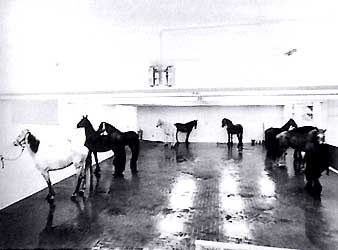
Jannis Kounellis: Untitled / Dodici Cavalli Livi, Rome; 1969
L'Attico Gallery
"12 living horses" - to quote Germano Celante
Number 12 stood for the day, the 12 months of the year, 12 signs of the Zodiac, 12 followers of Jesus etc.
The horse itself is an icon and archetype of life and freedom. In addition, it accompanies the dead to the "other side". With regard to the twelve horses of the Kounellis show, all this must be taken into account.
TV Gallery, Gerry Schum, land art, Berlin; 1969
With his wife and artist Ursula Wevers, Schum founded The TV Gallery and, later on, The Video Gallery.
The exhibition took place on TV. Its duration was the length of the program.
Over a period of six months, Schum shot films with Land Art artists. He wanted to dematerialise art - to take away the character of art as a consumer item (opposition to Pop art).
Bernhard Höke, Hannah Weitemeyer and Gerry Schum made the film Konsumkunst - Kunstkonsum (1967). In this film, artist Heinz Mack stated that his art will exist on television and will only be shown to the audience by this medium, only to be destroyed afterwards. Later, in May 1969, this was realized in the Telemack TV broadcast.
Otto Piene also made an exhibition only for TV - a multimedia show.
The influence of Le nouveau réalisme was also present in Berlin, where there was a problem with the transport of large art works, since overland shipping was difficult due to the vicinity of DDR, while air transport was too expensive.
Artists considered: Long, De Maria, Dibbets, Boezem, the "Event Structure Research Group", Flanagan and Smithson.
When Attitudes Become Form - 1969
curated by Harald Szeemann, himself an interdisciplinary-oriented person.
Contemporanea, Rome; 1973 / 74
Car-Garage in the underground of the Villa Borghese, curated by Achille Bonito Oliva.Interdisciplinary show including art, architecture, film, theatre, photography, dance, music, artists books, etc.
The development of the new expression in all these fields of art should be presented through a walk back into the past - starting in the year of 1973 and returning to 1955.
Literature
Bernd Klueser, Katharina Hegewisch: Die Kunst der Ausstellung,Frankfurt a. M., Leipzig 1995.
Bruce Altshuler, The Avant-Garde in Exhibition, New York, 1994.
Reesa Greenberg, Bruce W. Ferguson, Sandy Nairne: Thinking about Exhibitions, London, New York 1996.
Brian O'Doherty: In der weissen Zelle, Berlin 1996.
David Robbins: The Independent Group: Post-war Britain and the Aesthetics of Plenty, Cambridge 1990
- Oskar Baetschmann: Ausstellungskuenstler, Kultur und Karriere im modernen Kunstsystem, Köln 1997.
* Regretfully, the author was only able to send us the draft version of her text, which nonetheles seemed interesting and informative enough to be included in this publication.
Photos:
1. Armory Show, menu (with Duchamp illustrations) , New York, 1913
2. The Last Futurist Exhibition, view into the exhibition room
of Malevich, with black square, Petrograd, 1915
3. First International Dada-Fair, opening of the Dada fair, Berlin,
1920
4. El Lissitzky, Room of the Abstracts, Hannover 1927/28
5. Exposition international du Surréalisme, View into the main
room with coal bags by Marcel Duchamp, Paris, 1938
6. Galerija Peggy Guggenheim, Peggy Guggenheim's gallery, Art of This
Century, Room of The Abstracts, New York, 1942-1947
7. This is tomorrow organised by the Independent Group at the Whitechapel
Gallery, Patio and Pavilion, London, 1956
8. Yves Klein, Le Vide, photo of Yves Klein in the gallery space,
Galerie Iris Clert, Paris, 28th of April 1958
9. Claes Oldenburg, The Store, look through the shop window, 107E,
2nd. Street, New York, 1961
10. Dylaby, a dynamic labyrinth, room of Martial Raysse, Stedelijk
Museum, Amsterdam, 1962
11. Konrad Lueg and Gerhard Richter, Live with Pop - a Demonstration
of Capitalistic Realism, in the furniture department store Berges
in Düsseldorf, view into demonstration room, 1963
12. Gilbert & George, Living Sculpture, 1969 / 70
13. Gilbert & George, The Singing Sculpture, 1970
14. Jannis Kounellis, Without Title (Dodici Cavalli Livi), indoor view
of the gallery, Galleria L'Attico, Rim / Rome, 1969
15. Contemporanea, exhibition in an underground garage under Villa Borghese,
curator: Achille Bonito Oliva; Group Fluxus, Ben Vautier and George Brecht,
Rim / Rome, 1973 / 74